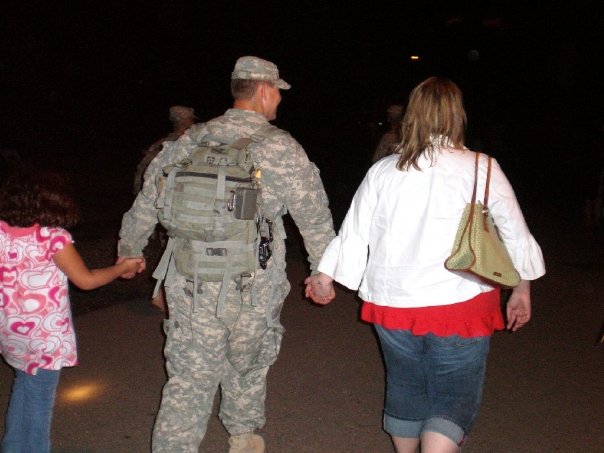“It starts with a family, not a veteran.”
That’s the first thing I wish someone had told me before Dave, my husband, began his PTSD treatment program. From the very start, I noticed glaring gaps in (Department of Veterans Affairs) VA family support, which left us to navigate trauma alone.

I thought we were walking into a process that would heal us—a way to stop the cycles of anger and trauma that had taken over our lives. Instead, the VA made it clear that I wasn’t part of the equation. The program focused on him, not us.
And it was then the cracks began to show. This systemic gap doesn’t just strain families—it undermines the very healing these programs claim to promote. For modern veteran families like mine, the stakes couldn’t be higher.
Families are not footnotes in the veteran’s story; we’re central to it.
Yet, the VA’s current model dismisses the realities of caregivers, spouses, and children. This failure harms everyone.
VA Family Support Challenges: The Missing Piece in Healing
The VA didn’t design its framework for the modern veteran family—a reality that many caregivers, including myself, have experienced firsthand. Its programs focus entirely on the individual veteran, as though their journey exists outside the web of relationships, responsibilities, and histories that make up a family.
But this approach doesn’t work.
Veterans don’t heal in isolation. Trauma reverberates within families—unspoken in late-night silences, echoed in tense conversations, and felt in the day-to-day weight of caregiving.
Yet the VA family support challenges persist:
- Treatment plans routinely exclude family members.
- Programs offer little to no resources for caregivers, who shoulder most of the burden.
- VA therapists prioritize the veteran’s perspective, leaving no room for accountability within the family dynamic.
Including caregivers and spouses in treatment plans from the very beginning would transform these outcomes. Structured sessions focused on family dynamics would equip veterans and their families with the tools to rebuild trust and address trauma together.
Before Dave entered his PTSD program, I fought hard for family involvement.
I asked difficult questions: How would his treatment address the impact of his trauma on our marriage? How could I, as his spouse, be part of the process?
The VA promised they would “consider” family involvement, but they never included us.
The sessions remained veteran-only. The treatment plans focused entirely on him. And the hard conversations we needed—about accountability, trust, and healing—never happened.
The Fallout of VA Neglect on Families
When Dave began EMDR therapy, I saw the changes almost immediately. The process unearthed his deepest traumas and helped him begin to process them—but it also pushed him further away from us.
By the second week, he became guarded. By the third, he grew angry—distant in a way I couldn’t reach. And by the end of the program, the VA had validated a version of his story that cast him as the only victim.
The VA program sent him a clear message: Leave the pain behind, reset, and start over.
And so he did. But where did that leave me and our son? We stood in the wreckage, wondering if the VA even noticed the destruction it caused. However, these outcomes didn’t have to happen.
Programs must include accountability frameworks that challenge veterans to recognize their role in family dynamics.
Therapy should help them take actionable steps toward rebuilding trust. Post-treatment follow-ups could also make a difference. Families need structured check-ins after programs like EMDR to navigate the challenges of reintegration.
Without these supports, families are left to carry the emotional, financial, and relational weight of healing and navigating the behaviors of their veteran on their own.
What Modern Veteran Families Need
The modern veteran family no longer fits the outdated image of a spouse waiting at home while the veteran returns from war. We navigate our own traumas, rebuild trust, and hold everything together in a system that refuses to see us.
But this isn’t just a story about what’s broken. It calls us to do better.
Here’s what family-inclusive care must include:
- Mandatory Family Involvement in Treatment Plans
Caregivers and spouses must participate in treatment plans from day one. Structured sessions should address family dynamics to ensure veterans and their families heal together. - Caregiver Support Resources
Families need ongoing access to therapy, training, and financial resources tailored to caregivers navigating PTSD and trauma recovery. Organizations like Wounded Warrior Project already help families like mine. We need more programs like this to ensure families aren’t left behind. - Accountability Frameworks
Therapy programs must provide space for veterans to take responsibility for their role in family dynamics. Actionable steps to rebuild trust must be part of treatment. - Post-Treatment Follow-Ups
Healing doesn’t stop when the program ends. Families need structured check-ins to manage reintegration and adapt to changes therapy brings. - Family-Focused Program Evaluation
VA programs must measure success by family outcomes, not just individual progress. Holistic evaluation ensures the entire system benefits from treatment, not just one person.
To Heal a Veteran, Support Their Family
This is the story of a modern veteran family—mine, yes, but also countless others standing in the same gap, navigating the same systemic neglect.
The VA claims its mission is to heal those who have served. But healing isn’t just about the veteran. It’s about the family that serves alongside them. When the VA ignores us, it fails its own mission.
So I ask:
Who heals the family when the veteran comes home?
Who helps us when the systems designed to support us turn away?
Because families like mine aren’t a footnote. WE ARE THE STORY.
And it’s time everyone—including the VA—started paying attention.

